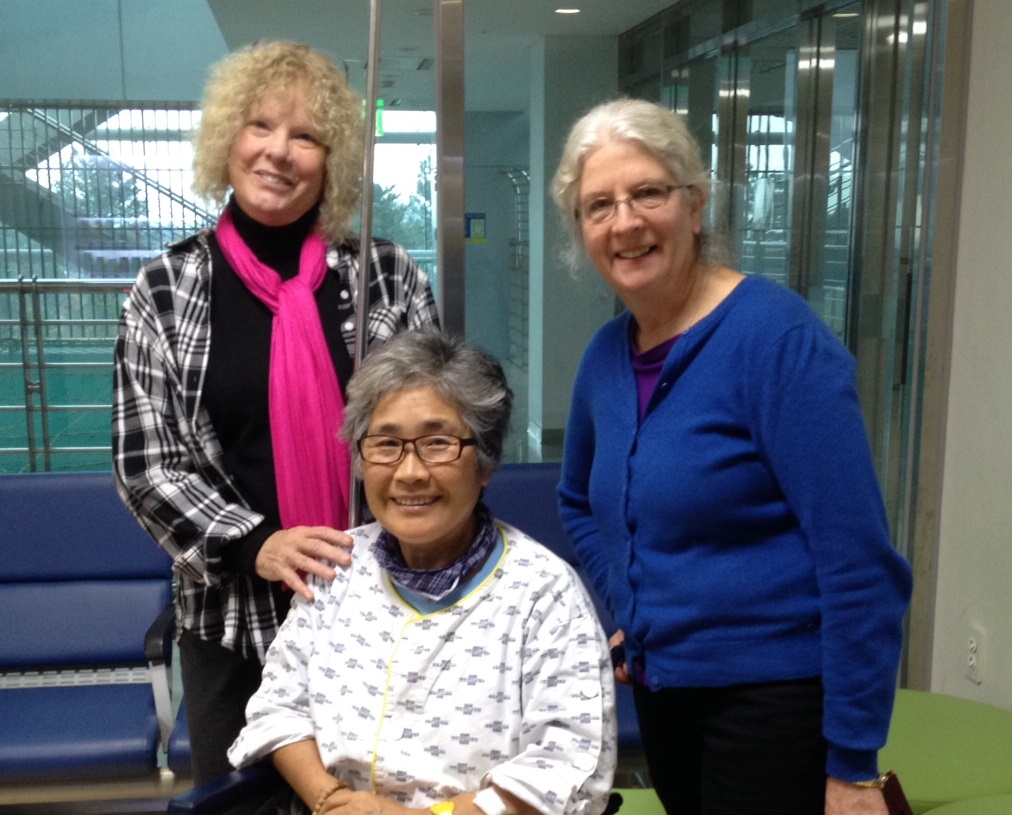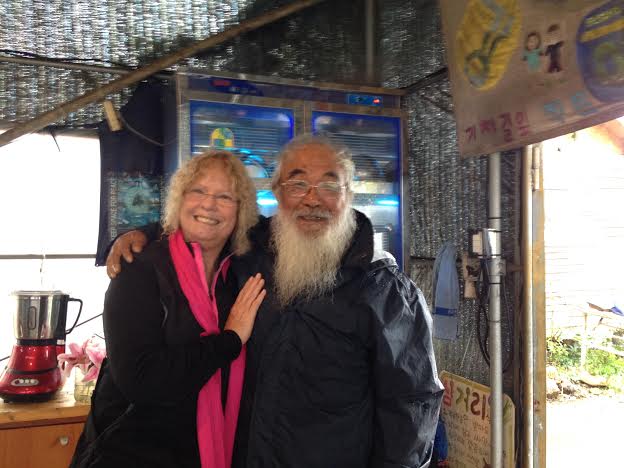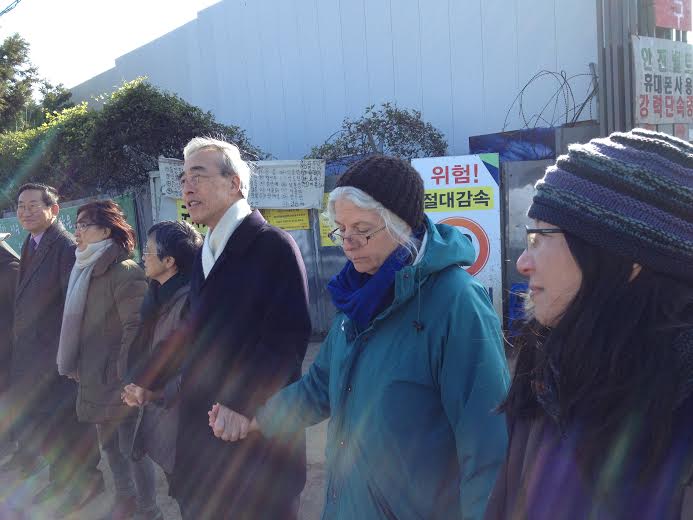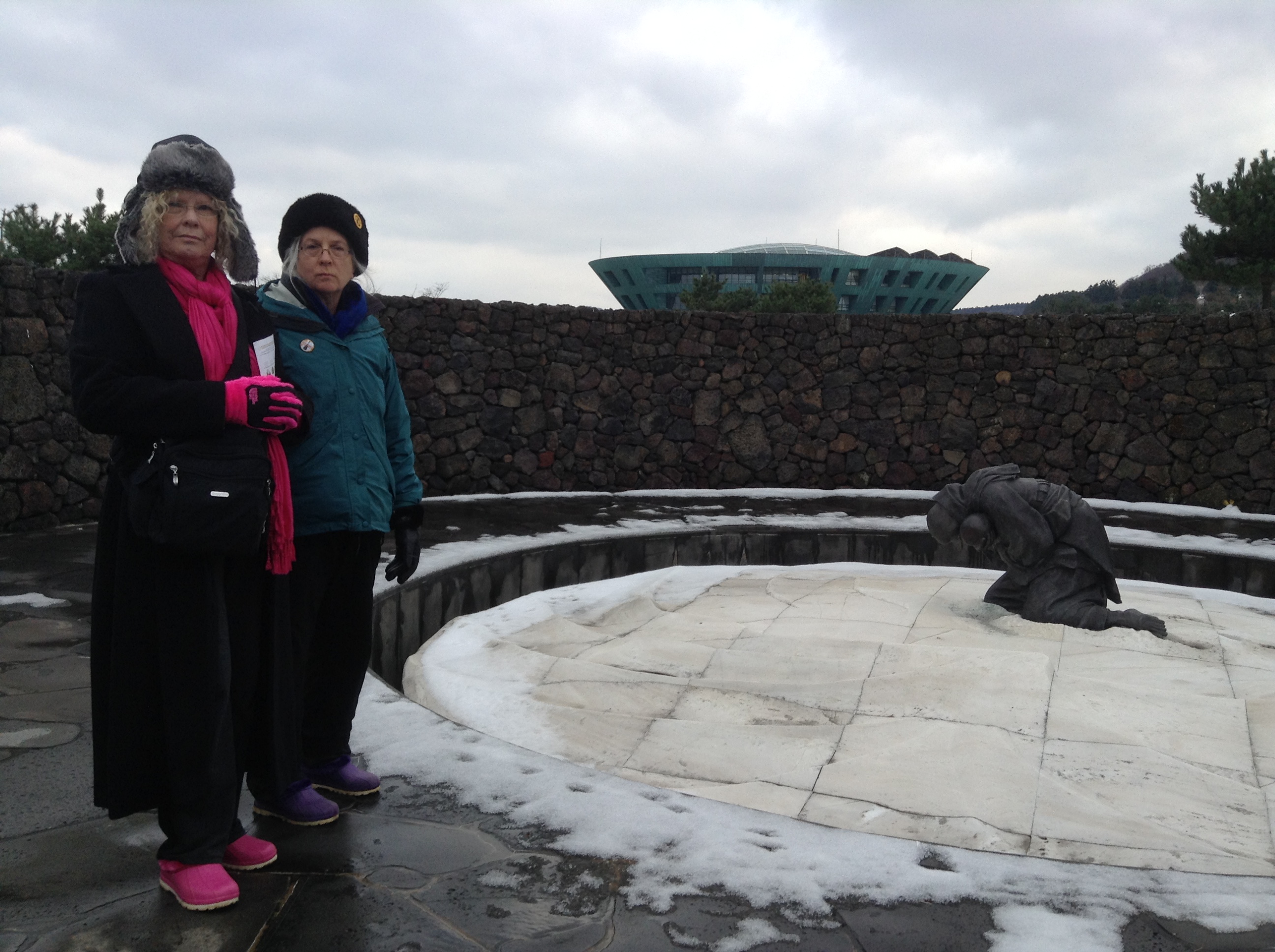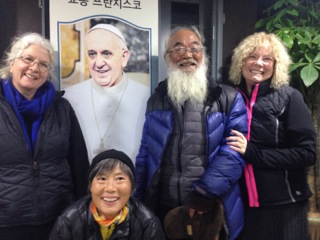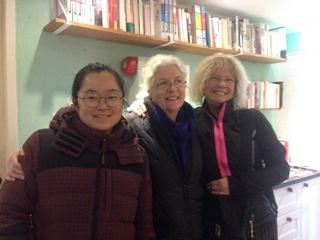From Dec. 9 to 27, two Catholic workers from the United States Martha Hennessy and Toni Flynn visited the village. While both joining daily activities of 100 bows and mass, Martha Hennessy, grand daughter to Dorothy Day, felt the need of further direct action. Here is her statement read on Dec. 23 when she stopped a military vehicle in front of the base construction gate. (For a photo and statement with Korean translation, see here). Please also see Martha’s interviews as a granddaughter of Dorothy Day with two Catholic media of Catholic Times (here) and Catholic News Now and Here (1, 2)

Photo by Gangjeong village/ Martha Hennessy, Granddaughter to Dorothy Day and New York Catholic Worker carries out direct action on Dec. 22. The Korean letters read, “No need of task flotilla in the Island of Peace.’
However, their visit was also filled with meetings with people and nature here. Here are some of the essays written by the two.
“Advent on Jeju – Dec 12, 2015 Feast of Our Lady of Guadalupe” Martha
& Toni’s 1st report from Jeju Island
Day 4
Gangjeong Village, Jeju Island
The weather in Gangjeong Village is cold and windy with intermittent rain blowing over Jeju Island. In contrast the Catholic peace community is warm, welcoming and grateful to us for joining them throughout December. We are all deep into Advent.
Gureombi Rock- a sacred site- is demolished, the Naval Base is built, and the Peace Community has been defeated in their struggle to prevent the construction and opening of the base.
The once pristine southern area of the island is now heavily militarized. Yet this community of villagers and activists maintain a prayerful presence at the gate, day after day, as they have for several years. This is about witness. This is about faithfulness. Although not all who participate are Catholic, this is where theCatholic Church truly breaks open the Body of Christ. This is where the Eucharist is paired with the crucifixion of the world. And this is
where the belief of Redemption is embodied in the faith of the people.
Each morning we wake up and walk a short distance from St. Francis Peace Center to join others at the gate of the naval base. The police, dressed in bright yellow uniforms, are ever present. We begin the ritual of one hundred bows in the darkness, and finish with the
dawning of the day. The Korean chanting and prayers during the bows mingle with our own inner prayers for our ancestors, family, and community members.
The daily heart and soul of the peaceful resistance culminates at the 11:00 AM Mass across from the gate. During Mass we sit in plastic chairs with priests, villagers, and activists, blocking the entrance to the base. The action proceeds nonviolently throughout Mass in a choreographed ritual between police and peacemakers. At three different intervals, police warnings intermingle with the words of the Mass as we are lifted chair and all, and moved to the side. Each time we return to sit at the gate. The priest then walks across the street bringing us communion and as we receive it, the meaning of the body and blood of Christ comes alive within us. The priest and nuns then lead us in reciting the Rosary, the Hail Marys blending with the roar of concrete trucks rolling in and out of the base. The Mass and Rosary have become inseparable from the activity of the base and the peacemakers’ efforts in the face of militarization.
At the conclusion of events, we walk to the nearby community kitchen where we enjoy the company of Jesuit priests and brothers, Franciscan nuns, local activists, and internationals.
We are served delicious Korean food including kim chi, glass noodles, rice, seaweed, and seasonal greens. We are reminded of Dorothy Day’s emphasis on the goodness of sharing a meal in common. Our lunchtime at the kitchen also serves as a means of decompressing from the intensity of the ongoing daily resistance.
We are steeped in the joy of coming together with our South Korean brothers and sisters during this Advent season. In the midst of resistance love flows out. We are grateful to all who supported us in our efforts to come here and our prayers join with yours.
“4 Vignettes from Gangjeong Village” by Toni Flynn – Calif CW
There is a pattern to our days now. Martha goes every morning at 7 am for the Hundred Bows. The weather is more fierce and I have been struggling with a sinus infection and sore throat so I read the hundred prayers from my room. “While holding in my heart that truth gives freedom to life, makeup first bow.” And each meditation deepens with each bow. (see attached doc for English translation)
After Bows, breakfast of rice, steamed eggs, yogurt and tangerines with Fr. Mun and others. Every one fusses over me wanting to help me get well so I am provided with healing elixirs, teas and various concoctions along with medicine. Martha is full of energy! She participates in every event enthusiastically. I on the other hand pace myself and enjoy one-on- one conversations.
—
The naval base is casting a huge shadow over this little village. Word is out that there will be more land used to construct housing for members of the military and their families. Some of the humble facilities set up by the peace activists will no doubt be torn down in the process, such as the community kitchen where all gather together after daily Mass to eat and converse.
Fr. Mun celebrated the 50th anniversary of his priesthood last night at the St. Francis Peace Center where he lives and where Martha and I are guests. So much food as we joined many of his friends to celebrate around a big round table. We dined on fish, snails (ok I passed on the snails), octopus (passed on that too!), seasoned rice, vegetables, and an array of other edible delights.
It was good to see the faithful women, Fr. Mun, the Jesuits and Diocesan priests find cause for celebration because they have all suffered and sacrificed so much over years of time in opposition to military presence.
—-
Mr. Oh lives in the village. He is, I believe, a Quaker. During every Mass at the entrance to the naval base, he performs a solitary funeral march, dressed in traditional pale yellow mourning clothes and a mourning hat that resembles a French baker’s hat. In silence, he slowly circles the area between the makeshift chapel on one side of the street and the entry to the base on the other side. Mr. Oh. He takes three steps, bows, places his hands on the ground, then his knees, then rises and repeats over and over again, around and around while Mass continues. His grief represents the grief of the community over the loss of their sacred rock, Gureombi; the loss of sea life; the loss of their peaceful existence. Mr. Oh’s beard is gray; his face is ancient, his eyes are piercing. One evening he sang songs and his voice was filled with sorrow, passion, strength. I would not be surprised if his songs were heard across the ocean.
—
See attached photo: This is JeJu’s non-violent Joan of Arc. She is a faithful witness at the entrance to the naval base. Two weeks ago a cement mixer truck ran over her foot while she stood at the gate. She has been in the hospital ever since. We visited her there, kindness of Fr. Kim. Joan of Arc is a woman on fire with love of this Island and the villagers. She will soon return to the naval base gate to continue with prayerful yet persistent protest. God bless Joan of Arc and all the brave priests, nuns and activists! Martha and I are already transformed by joining with them during this Advent time.
—–
“Summary of JeJu’s struggle” by Toni Flynn
The future of Gangjeong Village looks grim as does the future of JeJu Island as a whole. On another side of the Island a second civilian airport will be built. Along with more environmental destruction there is suspicion that eventually this airport will include an Air Force presence. As for Gangjeong Village, activists believe that the newly opened naval base is turning an abstract danger into a definite one by offering practicality to the U.S. and thereby
posing a threat to China. Daily life of the villagers has forever changed. What once was a unified village of peace and pristine beauty is now a militarized area with some in the village approving and some opposing the naval base. There are two family operated convenience stores in the village on two sides of the same street. One shop approves of the naval base and the other supports the opposition to the base. Before the base, these shop owners good neighbors. Now they symbolize a split village. In time, the expansion of the base along with the influx of military people and their families will overwhelm and influence the village people, their schools, shops and their village culture. The base will house not only military staff but submarines, weaponries, and war ships. The peacemakers in Gangjeong ask “How do we avoid war by building and preparing for more war?” These activists say that the struggle in Gangjeong is not only important to the locals or to the larger Korean population, but it.is of significance to all peaceful movements and peace communities around the world. We must all persevere in imagining and implementing alternatives to state violence and wars. Here is a poem for the children of Gangjeong by the poet Shin Kyung- Rim: My dears, you must be so proud of your parents who are struggling to save your village. A
day must come when we will all remember the beauty of this long struggle.
“My visit with Fr Mun” by Toni Flynn
Martha prayed the Hundred Bows at the gate this morning (she does the Bows faithfully every day) and has gone to pick tangerines with the villagers. I stayed back at the Peace Center for a visit with Fr. Mun in his work shop. He is a remarkable man of many talents with a nature that is both passionate and peaceful. His workshop is his sanctuary. There he practices his accordion and smokes an occasional cigarette. Most of the time he carves wood, creating art that speaks of struggle and peace. At breakfast today, Fr. Mun told me and Martha “We have no guns. We resist militarism with open hands.” He added “I used to love walking around in Gangjeong Village viewing the.beauty. Now I hate walking around because of the sight of the naval base structures.” Fr. Mun, Martha and I agreed that the new St. Francis Center is a solid, tangible sign of hope in the midst of all the military buildings – it is four stories high and welcomes everyone. As I started to leave Fr. Moon’s work shop he gave me a gift – a dramatic
wood carving of the suffering Christ wearing a crown of thorns. Below the face of Christ are the words in Korean: Beginning now. Peace.
Fr Mun Sings:
Below links to youtube clips of Fr Mun singing the three songs he
sings daily at Navy Gate during Mass and the Rosary.
https://www.youtube.com/watch?v=i3l8DXj5RCs
https://www.youtube.com/watch?v=uxhUdUO1-MI
https://www.youtube.com/watch?v=rbOnExXQy14
33 photos of Martha Hennessy and Toni Flynn at Jeju Navy Gate Witness Dec 2015
https://www.flickr.com/photos/frank_cordaro_and_the_dm_catholic_worker/albums/72157660191689933
The destruction of Gureombi Rock is a challenge to the human
civilization and the creation of God” Bishop Peter Kang
—
“Bishop Peter Kang -The Catholic Voice for Peace” by Martha Hennessy
Peter Kang, appointed bishop of Cheju in 2002, speaks fluent English with a gentle British accent. He studied in Japan and Rome and is known for his wisdom and compassion to both the people of Cheju, and those of downtown Seoul where he served for 25 years. He considered it God’s recompense to come to this place of fresh air and natural beauty after the noisy, smoggy city. He became aware of the tragic side of the history of the island when he moved here. As a well-educated Korean he knew little of how the island was used by United States Cold War military interests following the end of the Japanese occupation from 1910 to 1945.
These circumstances led to the slaughter of at least 30% of Cheju’s population from 1948 through 1953. Eighty-four villages were permanently destroyed. Bishop Kang expressed sadness and remorse over this history, that his government had committed such crimes. The majority of Koreans know very little about what really happened. A governmental cover-up has persisted for decades.
In 2000 an investigative study was finally allowed and the full report was completed in 2003. Bishop Kang and others traveled to Washington D.C. in April of this year to present the report to Congress but were invited to meet only with two congressional secretaries. South Korean/U.S. government interests had informed the Congress and biased them against meeting in person with the small contingent. Bishop Kang and the others have not heard from the U.S. Congress regarding the documentation of the slaughter of Cheju islanders.
The people of Korea are under significant pressure to not question the government and military in the interest of national security. Any dissenting voice is painted as “communist” and the military defense has free reign, with U.S. backing. This collaboration with the U.S. is considered essential to the existence of South Korea even as the threats of North Korea are now known to be inaccurate. An attempt was made by the South Korean president in 2002 to regain the right to direct military decisions during a time of war back into the hands of the Korean military. The current president, Park Geun-hye rolled back this effort and the U.S. continues to hold the highest level of control of any military decisions if war is declared.
Bishop Kang has expressed opposition to the building of the naval base on Cheju against the will of the people. It is imposing yet another layer of trauma on the people following the history of the massacres before and during the Korean War. He recently made five points during a homily given for the opening of St. Francis Peace Center in Gangjeong in September.
“Firstly, war is disaster. It cannot be a solution between nations. It is because such thing did not happen in the past and would not happen in the future, either.”
“Secondly, when a state power takes armed force, it can be justified and get citizens’ sympathy only by strict conditions. The mobilization of state power against the struggle in opposition to the Gangjeong naval base can never be of self-defense.”
“Thirdly, modern arms are weapons of massive mankind-killing. The increment of arms cannot be connected to peace.”
“Fourthly, we are dumping tremendous budgets into arms production. What if it is used for the nation’s progress, for the poor?”
“Lastly, why should there be a military base in Cheju, the far-most from the Korean truce line and tainted by the wounds of the April 3rd [1948] incident? Cheju is the Peace Island designated by the government. The relationship between any military base and the Peace Island is like water and oil.”
“With the construction of the naval base, the death of the April 3rd spirits has become meaningless…”
Bishop Kang cited both Catholic social teaching and the United Nations Charter to reinforce his position regarding the Korean/US naval base construction. The Jesuit provincial has permanently assigned two priests and a brother to continue carrying out daily Mass at the gate with the participation of Franciscan and Benedictine nuns, and others from the Catholic community. It is this Mass that allows the resistance to continue to block the military base for two hours every day, making the traffic wait going in and out of the entrance.
We will be holding Mass at the Chapel across from the gate on Christmas Eve, and again at the gate on Christmas Day. Bishop Kang will join in solidarity with the community stating: “the work has only just begun.”
—
Bishop Kang for Truth TV – YouTube, Published on Oct 6, 2012
https://www.youtube.com/watch?v=y0_cfYBz7fg
“I interviewed the bishop of Jeju Island, His Excellency Peter Kang on the last day of my stay on Jeju Island. Bishop Kang is an outspoken critic of militarism and arms buildup, and a strong advocate for the Church to be involved in issues of social justice and peace.” Regis
Tremblay
“Catholic bishop reflects on the tumultuous story of Jeju”, The Hankyoreh March 9, 2012
http://www.hani.co.kr/arti/english_edition/e_national/522761.html
Catholic Priests unite despite navy and police insult. Bishop Kang U-Il says, “Peace is the result of justice and love.” Posted by Save Jeju Now, Nov. 13, 2012
http://savejejunow.org/catholic-priests-kang-u-il/
—
Martha Hennessy
Toni Flynn
—
Video clips from the daily Mass and Rosary at the Jeju Navy Base main gate
Dec 17, 2015 Martha dancing at Jeju Navy base gate (1min 55sec)
https://www.youtube.com/watch?v=GzMk1ncy7RM
Dec. 18, 2015 Martha carried of drive Jeju Navy base (1min 50sec)
https://www.youtube.com/watch?v=l-EYpy7YsqE
Dec. 19, 2015 Toni carried off drive (1min 49sec)
https://www.youtube.com/watch?v=HmtOernj4W0
Dec. 19, 2015 Martha dancing – Toni sitting… (2min 41sec)
https://www.youtube.com/watch?v=-aXzt-qoxtA
Dec 20, 2015 Communion Toni and Martha at the gate (5min)
https://www.youtube.com/watch?v=kHn8AZwRMN4
Dec 21, 2015 Martha and Toni carried off drive (1min 45sec)
https://www.youtube.com/watch?v=wa1ko4I4TEk
Dec 21, 2015 Line Dance – Toni and Martha (3min)
https://www.youtube.com/watch?v=l-5SHdiCI08
—-
“My heart is forever changed”
by Martha Hennessy
My heart is forever changed by what I saw, heard, and received at the naval base gate in Gangjeong village. The effects of jet lag linger and my mind holds on to the people who remain there, carrying on the struggle. The 100 bows begun in the dark, the Mass at the gate, the recital of the Rosary amidst roaring construction machines, the constant witness. The sound of knocking, grinding, giant jackhammers tearing away at the island still rings in my head. Our peacemaking efforts have taken on a tremendously stronger meaning when practiced in the context of what Father Bill from Tacoma called Eucharistic resistance.
There is always the urgent feeling that we are not doing enough. I would awaken at 5 in the morning; my soul feeling devoured by this scourge taking form near the St. Francis Peace Center. One morning after the 100 bows I crossed onto the concrete breakwater at the sea’s edge and had a bird’s eye view onto the front of the base. The massive wall dwarfed me, leaving me feeling puny and helpless in the face of this insistent, mindless drive towards destruction. Standing at the gates of Mordor my very being clamored for protection and safety. I also felt like throwing myself at it. The construction workers continued with their jobs, oblivious to the wailing of heaven and earth, grieving over this great sin. I trudged back to the Center for breakfast feeling empty, distraught. I can only begin to imagine the toll this has taken on all the people who have sustained their efforts of resistance over the long haul.
On my way home through Seoul, I was able to meet with a small group of representatives from labor unions, mothers for peace, and the Protestant community. Labor leader Han Sang-Gyun is now imprisoned and on hunger strike. Police oppression continues to grow in South Korea, along with civil unrest. The demonization and exaggerated threat of North Korea is used to justify the purchase of yet more military weaponry from the United States. I spoke of the crucified body of Christ as I saw it on the island of Jeju. We all struggle to link the many causes together that make up the picture of global oppression and violence. Martin Luther King, Jr. and Philip Berrigan spoke of the need for a general strike to shut down the economy of nations run amok. But we must have in hand a ready list of clear demands needed to reform the structures of sin. Together, how do we lay out a new world in which it is easier to be good?
Meanwhile I am back in Vermont, helping to care for small grandsons, and waiting for the ewes to give birth, no doubt holding off from the cold spell ahead. We must hold all of these things in our hearts.
Enjoying time with our hosts before our departure from St. Francis Peace Center in Gangjeong.







